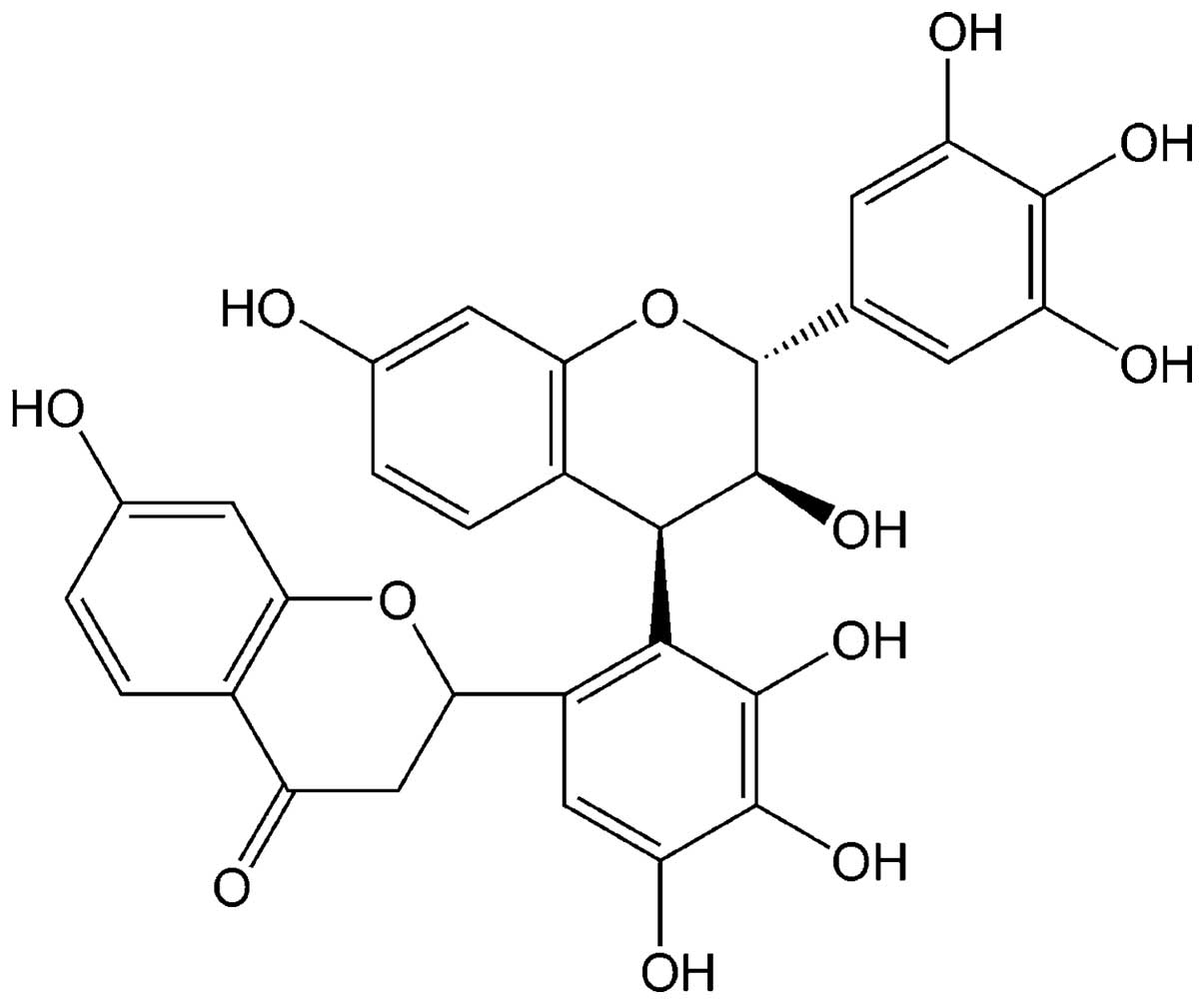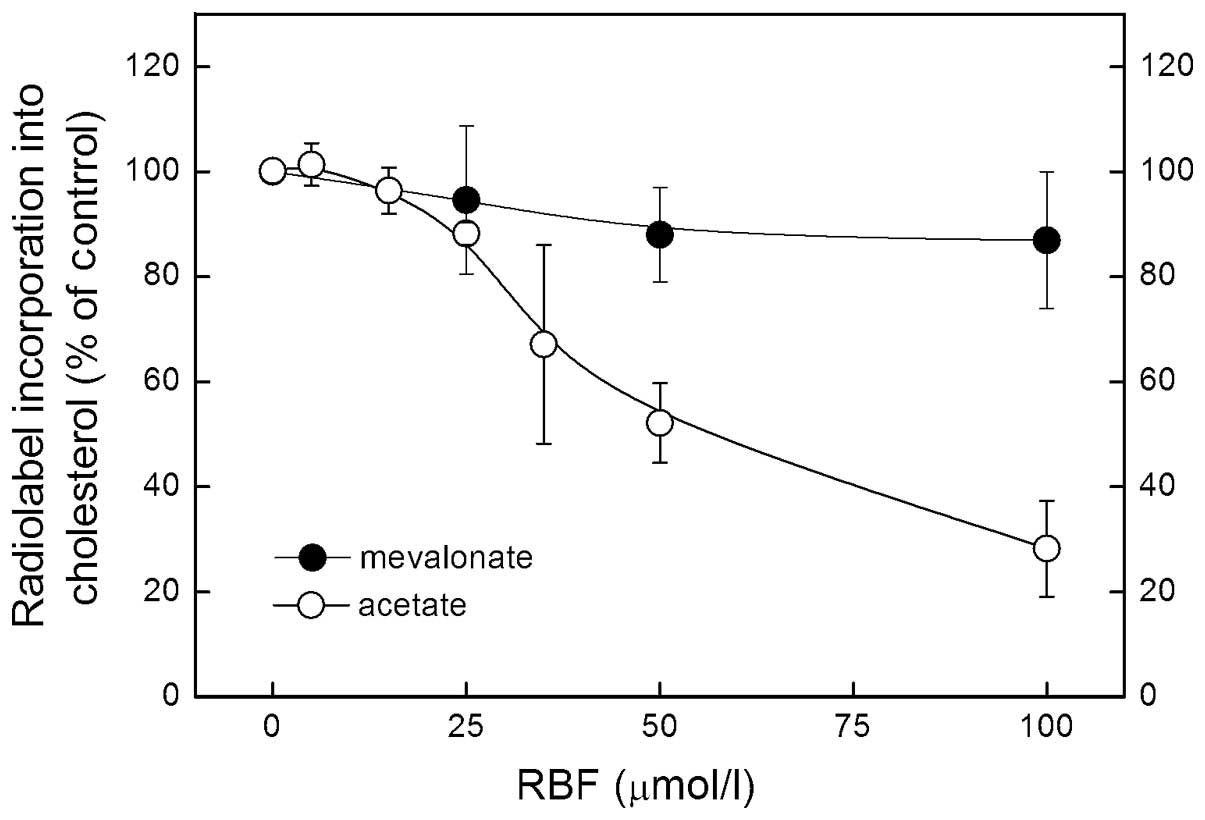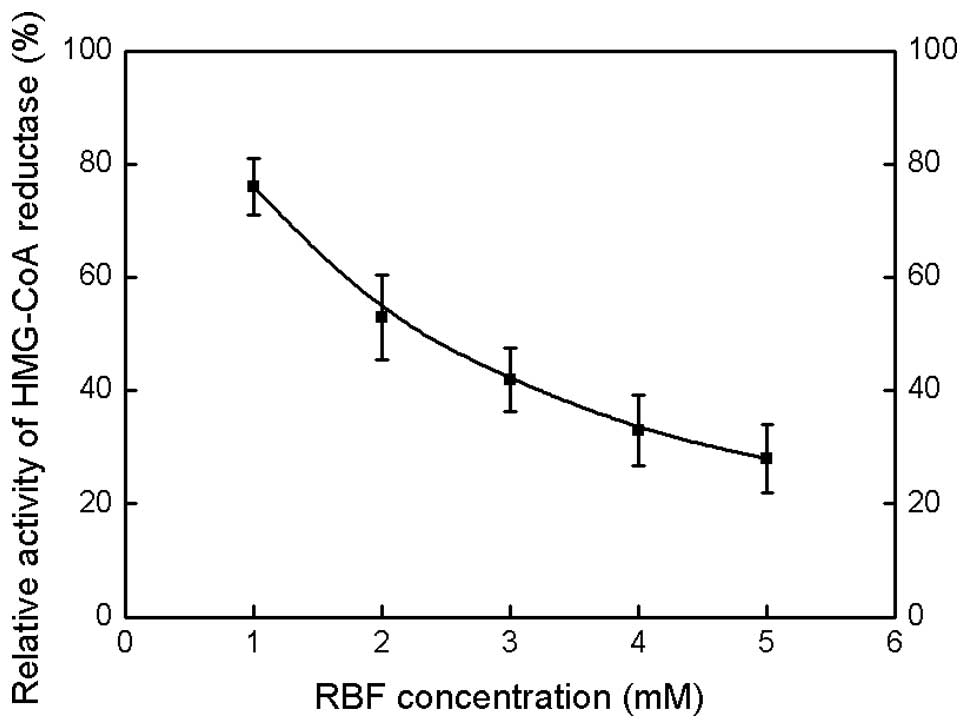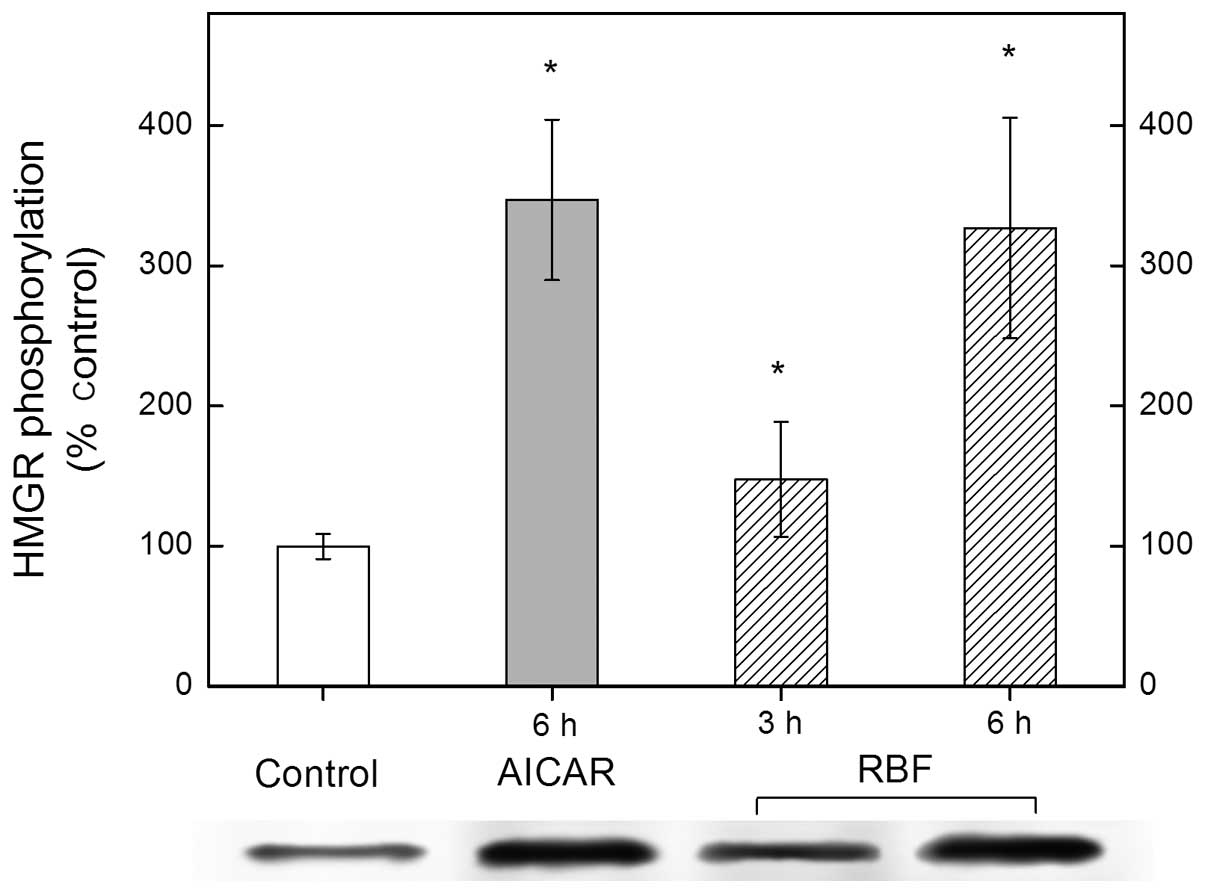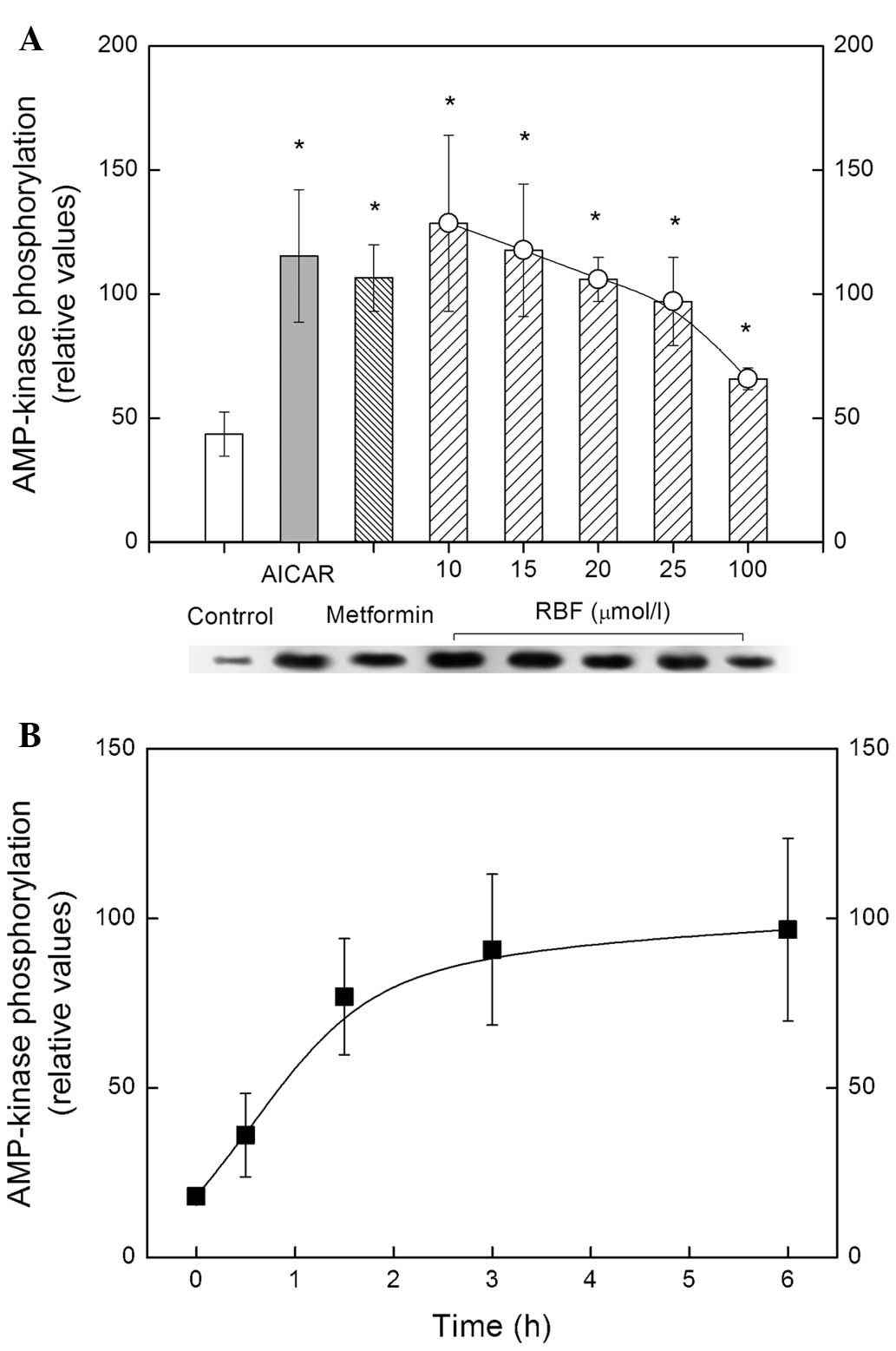Robinetinidol‑flavone attenuates cholesterol synthesis in hepatoma cells via inhibition of 3‑hydroxy‑3‑methylglutaryl‑coenzyme A reductase
- Authors:
- Published online on: October 23, 2014 https://doi.org/10.3892/mmr.2014.2758
- Pages: 561-566
Abstract
Introduction
Robinetinidol-(4β,2′)-tetrahydroxy-flavone (RBF, Fig. 1), is found in the bark of the leguminous tree Acacia mearnsiid De Wild and has been shown to exhibit anti-obesity properties (1). The mechanism by which RBF affects obesity may be attributable to its effect on cholesterol synthesis (2), since cholesterol is crucial to the development of atherosclerosis (3). RBF may therefore prove useful in the treatment of atherosclerosis.
A number of studies have demonstrated that flavonoids, together with other polyphenols, such as luteolin and quercetin, decreased cholesterol synthesis by direct inhibition of squalene monooxygenase, a rate-limiting enzyme involved in cholesterol synthesis (4–8). These results have suggested that polyphenols may inhibit 3-hydroxy-3-methylglutaryl-coenzyme A (HMG-CoA) reductase, an important enzyme in the synthesis of cholesterol (4,9–11). However, RBF is an oligomeric condensed polyphenol, which may exert additive effects, compared with those of individual polyphenols, on cholesterol synthesis. In view of its directly and indirectly influencing cholesterol synthesis, together with its nature and safety characteristics, RBF may be useful as a therapeutic compound for the prevention of atherosclerosis. However, the majority of studies to date have been conducted in vitro, which is significantly more simplistic than the in vivo process. In addition, the mechanisms by which RBF reduces cholesterol have not yet been established.
The cholesterol biosynthetic pathway is highly regulated, and is subject to transcriptional, translational and post-translational modulation (12). HMG-CoA is a pivotal rate-limiting enzyme within the cholesterol biosynthetic pathway (13). The activity of HMG-CoA reductase is subject to post-translational modification through its degradation and its inactivation by phosphorylation (12,14). Adenosine monophosphate (AMP)-kinase is the principal kinase involved in the phosphorylation-mediated inactivation of HMG-CoA reductase, and is itself activated by phosphorylation (15–16).
The present study investigated whether RBF inhibits cholesterol synthesis in hypercholesterolemic rats and MC-RH-7777 hepatoma cells, and the possible mechanisms underlying this effect.
Materials and methods
Materials
Acacia mearnsiid De Wild bark was obtained from Guangxi Wuming Tannin Technology Co., Ltd. (Nanning, China). Lipoprotein-free calf serum, AICAR, 1,1-dimethylbiguanide hydrochloride (metformin) and protease inhibitor cocktail were obtained from Sigma (St. Louis, MO, USA). HALT phosphatase inhibitor and a bicinchoninic acid (BCA) protein assay kit were obtained from Peking Luqiao Bio-tech Co. (Beijing, China). Dulbecco’s modified Eagle’s media (DMEM), penicillin-streptomycin-glutamine, trypsin and fetal bovine serum (FBS) were obtained from Qi’ao Bio-tech Co. (Shanghai, China). Radiochemicals (14C-acetate at 56 mCi/mmol, 14C-mevalonate at 65 mCi/mmol and 14C-hydroxymethylglutaryl-CoA at 55 mCi/mmol) were obtained from American Radiolabeled Chemicals (St. Louis, MO, USA).
Extraction, isolation and identification of RBF compound
Extracts of Acacia mearnsiid De Wild were obtained via aqueous acetone (1:1) immersion of bark drillings (10 kg) for seven days. The acetone was evaporated and the aqueous solution was freeze dried, yielding a yellow-brown powder (554 g) which was partitioned into four 80-g samples between a butan-2-ol-water-hexane (5:4:1) mixture in a 20-tube, 100 cm3 under phase, Craig countercurrent assembly (Shanghai Chemical Machinery Plant Co., Ltd. Shanghai, China). Qualitative paper chromatographic analysis produced five main fractions. Subsequent column chromatography of fraction 3 (52 mg) on Sephadex LH-20 (5×170 cm column, flow rate 20 cm3/30 min) yielded 12 fractions. Sub-fraction Fr-3–5 (1020 mg) was further purified into five main fractions via semi-preparation chromatography. The most active fraction, Fr-3-5-2 (Rf 0.34, 43 mg), underwent further purification. Acacia mearnsiid De Wild bark tannins contained 93% RBF by high performance liquid chromatography, and contained M+, 700.2518 (theoretical molecular mass of C39H40O12, 700.2520), in the peracetate mass spectrum (Thermo Fisher Scientific Inc., Waltham, MA, USA). Purified RBF was stored at 4°C.
Animals and treatment groups
Male Sprague-Dawley rats (weight, 200±25 g; Dossy Biological Technology Co., Ltd., Chengdu, China) were housed in groups of five under standard environmental conditions (23±10°C, 55±5% humidity and a 12 h light/dark cycle) and had free access to water and a standard diet, which consisted of AIN-93G, (Beijing Lianlixin Biological Technology Co., Ltd.) containing 200 g/kg casein lactic, 3 g/kg L-cystine, 397 g/kg corn starch, 132 g/kg maltoes dextrin, 100 g/kg sucrose, 50 g/kg cellulose, 70 g/kg soybean oil, 35 g/kg mineral mix, 10 g/kg vitamin mix and 2.5 g/kg choline bitartrate. All animal experimentation was performed in strict accordance with the recommendations set out in the Guide for the Care and Use of Laboratory Animals of the National Institutes of Health. The protocol was approved by the Animal Care and Use Committee of the Sichuan University (Chengdu, China; permit no. 24). All surgery was performed under sodium pentobarbital anesthesia and all efforts were made to minimize suffering.
The forty rats were randomly assigned to four groups: A negative control group (NC group); a positive control group, fed a high-fat diet (HF group); a low dose RBF group (60 mg/kg/day); and a high dose RBF group (120 mg/kg/day). The rats of the NC group were fed with a standard diet and orally treated with 0.3% Tween-80 solution (10 ml/kg). The rats of the HF and RBF groups were fed with a high fat diet, comprising 7.5% pork oil (Chengdu Zhiwei Food Co., Ltd., Chengdu, China), 1% cholesterol (Sigma Chemical Co., St. Louis, MO, USA), 10% egg yolk powder (Chengdu Aimeiai Food Co., Ltd., Chengdu, China), 0.3% chocolate (COFCO Le Conte Food Co., Ltd., Shenzhen, China), 0.2% propylthiouracil (Sigma Chemical Co., St. Louis, MO, USA) and 81% standard diet, and gavaged with 0.3% Tween-80 solution (Sigma Chemical Co., St. Louis, MO, USA) or RBF solution, respectively, daily for six weeks.
Cell culture
McA-RH-7777 rat hepatoma cell lines, obtained from Shanghai Maisha Bioscience Co. (Shanghai, China), were cultured in DMEM supplemented with 100 U/ml penicillin and 100 lg/ml streptomycin (Sigma-Aldrich, St. Louis, MO, USA) containing 10% FBS. The cells were incubated at 37°C in a 5% CO2 atmosphere.
Assessment of liver index
At the end of the treatment period, rats were kept for overnight fasting and then given the final gavage. Rats were weighed and anesthetized with 36 mg/kg sodium pentobarbital (Sigma-Aldrich) by intraperitoneal injection to collect blood samples from the aorta ventralis 1.5 h after the gavage. Following blood collection from rats sacrificed by anoxia, the livers were removed and weighed in order to calculate the liver index (liver weight/body weight). The plasma was separated by centrifugation at 1,000 × g for 15 min at 4°C. Plasma samples were stored at −80°C until required for analysis.
Biochemical analysis of serum
Serum total cholesterol (TC) and triglycerides (TG) were measured in a spectrophotometer (DU800, Beckman Coulter, Pasadena, CA, USA) using commercial kits (Jiancheng Institute of Biotechnology, Nanjing, China) according to the manufacturer’s instructions (CHODPAP and GPO-PAP methods). The optical density of the samples was measured on a spectrophotometer at a wavelength of 546 nm. Total levels TC and TG in the serum were calculated by dividing absorption of the tested sample by that of the standard sample and multiplying by the TG and TC content of the standard sample. Serum low density lipoprotein cholesterol (LDL-C) levels were evaluated according the manufacturer’s instructions (polyethylene sulfate precipitation method) to evaluate the difference between cholesterol in the supernatant and total cholesterol.
Determination of cholesterol synthesis in hepatoma cells
Following culture for 48 h in six-well plates, hepatoma cells were treated with 14C-acetate or 14C-mevalonate for 3 h. The RBF concentration (1, 2, 3, 4 or 5 mM) was included in incubations with 14C-mevalonate in order to inhibit the activity of HMG-CoA reductase. The medium was removed and cells were washed three times with phosphate-buffered saline (PBS), harvested by trypsin, resuspended in 20 mM Tris buffer (pH 7.4, containing 0.1% Triton X-100; Sigma-Aldrich) and lysed by a sonication three times for 5 sec (Shanghai Bilon Instruments Co., Shanghai, China) on a medium setting. Lipids were extracted into 5 ml chloroform/methanol (2:1). The medium was reduced to near dryness using Savant Speed Vac SC100 apparatus (Selby Anax, Adelaide, Australia). Dried extracts were resuspended in 50 μl chloroform/methanol and resolved by silica thin-layer chromatography (Whatman, Plc., Little Chalfont, UK) in petroleum ether/ethyl ether/acetic acid (60:40:1). Radiolabeled cholesterol was identified by comparison with standards visualized by iodine-vapor stain and quantified by electronic autoradiography (Packard Instant Imager, PerkinElmer Inc., Waltham, MA, USA).
Isolation and assay of HMG-CoA reductase activity from rat livers
Microsomal fractions were prepared from livers of the rats maintained on rat standard diet containing 5% cholestyramine for seven days. HMG-CoA reductase was solubilized from the microsomal fractions according to the method described by Heller and Shrewsbury (17) and purified through the second ammonium sulfate precipitation step described by Kleinsek et al (18). The enzyme preparation was stored at −80°C in 100 μl aliquots until required for analysis. Prior to use, the enzyme was activated at 37°C for 30 min. The assay was adapted from methods described in the study by Beg et al (19). In brief, the reaction mixture contained 100 μl of 0.14 M potassium phosphate buffer, pH 6.8; 0.18 M KCl; 3.5 mM EDTA, pH 7.0; 10 mM dithiothreitol; 0.1 mg/ml bovine serum albumin; 0.04 μCi of 14C-HMG-CoA; and 8 μg partially purified enzyme (specific activity 14 nmol/min/mg) with or without RBF. Following incubation for 5 min at 37°C, the reaction was initiated with 0.2 mM NADPH and terminated with 20 μl of 5 M HCl. Following an additional incubation for 30 min at 37°C to allow for complete lactonization of the product mevalonate, the mixture was passed through a column with an internal diameter of 0.5 cm and a length of 5 cm, which contained 100–200 mesh Bio-Rex, chloride form (Bio-Rad, Hercules, CA, USA). Any unreacted 14C-HMG-CoA was adsorbed onto this mesh. The product of 14C-mevalonolactone was eluted into scintillation vials with 3 ml distilled water. After the addition of 15 ml Aquasol II (Sigma-Aldrich), the radioactivity of the samples was measured.
Immunoblot analysis of HMG-CoA reductase and AMP-kinase phosphorylation
For western blot analysis hepatoma cells were grown in 6-cm plates for 3–5 days with a daily medium change. Cells were treated with RBF or an AMP-kinase activator (AICAR or metformin, 1 mM final concentration) for 3 h in fresh media. Subsequent to the incubation period, cells were washed once with ice-cold PBS and removed with lysis buffer composed of, 0.25 M Tris buffer (pH 7.5), and protease and phosphatase inhibitor cocktails at standard concentrations. Lysates were centrifuged at 1,300 × g for 10 min at 4°C and the supernatant was stored at −80°C. Protein (30 μg, identified by BCA analysis) was fractionated by SDS-gel (8%) electrophoresis and transferred onto to a nitrocellulose membrane (Whatman; Sigma-Aldrich) The membrane was blocked with 0.05% Tween-20 and 5% non-fat milk. For immunodetection, a rabbit antibody against total AMP-kinase (polyclonal anti-AMPK α-pan, 1:2,000; Upstate Biotechnology Inc., Charlottesville, VA, USA) or phosphorylated AMP-kinase (anti-phospho-AMPKα, 1:500; Upstate Biotechnology Inc.) were used overnight at 4°C. Antibody binding was detected with a horseradish peroxidase (HRP)-conjugated polyclonal secondary goat anti-rabbit antibody (1:1,000; Chengdu Aoxin Biotechnology Co., Ltd., Chengdu, China) for 1 h at room temperature. The chemiluminescent image (Supersignal West Pico Chemiluminescent Substrate, Pierce Biotechnology, Rockford, IL, USA) was captured by autoradiography. Band densitometric analysis was conducted using Image J 1.416a (National Institues of Health, Bethesda, MD, USA). In order to determine the degree of HMG-CoA reductase phosphorylation, lysates were incubated for 1 h at 4°C with 20 μl mouse monoclonal antibody against phosphoserine/phosphothreonine/phosphotyrosine (51AB Biotech Co., Shanghai, China). Antibody conjugates were precipitated with 35 μl of protein G Plus-Agarose from Calbiochem (La Jolla, CA, USA) following Amersham Biosciences (Chalfont St. Giles, UK) immunoprecipitation instructions. Immunoprecipitated protein was released by boiling in a gel loading buffer, fractionated by SDS-gel electrophoresis and transferred to a nitrocellulose membrane. HMG-CoA reductase was detected and quantified via rabbit polyclonal HMG-CoA reductase antibody (Upstate Biotechnology Inc.), followed byincubation with an HRP-conjugated secondary goat anti-rabbit antibody, as described above.
Statistical analysis
All values are expressed as the mean ± standard deviation. The groups were compared using unpaired Student’s t-test. P<0.05 was considered to indicate a statistically significant difference.
Results
RBF inhibits cholesterol synthesis in vivo
Following a six week hypercholesterolemic diet, the serum TC in rats increased by 166%, from 52.55±2.53 to 140.05±6.77 mg/dl. Treatment with 120 mg/kg RBF significantly reduced cholesterol levels in the treated groups, with serum cholesterol being 25.9% lower than that in the positive control groups (Table I).
No changes in the serum levels of LDL cholesterol and HDL cholesterol were observed in the sham groups fed with a standard diet and treated with RBF, compared with the negative control group. In the treatment groups, 120 mg/kg RBF reduced mean serum LDL-C levels by 50.8%, from 79.93±6.59 to 38.72±4.11 mg/dl, whereas no significant changes were detected in HDL-C levels (51.81±3.28 to 47.01±2.91 mg/dl, P>0.05). RBF treatment therefore resulted in a decrease in the LDL/HDL ratio of 66% in hypercholesterolemic rats (Table I), indicating that RBF had a greater effect on LDL-C than HDL-C levels.
RBF inhibits cholesterol synthesis in vitro
In a 3 h assay, addition of RBF to McARH7777 rat hepatoma cell cultures decreased the incorporation of 14C-acetate and 14C-mevalonate into cholesterol (Fig. 2). RBF-mediated inhibition of 14C-acetate incorporation into cholesterol was evident at 35 μg/ml and reached 72% at 100 μg/ml. By contrast, even at the highest concentration of RBF tested, inhibition of 14C-mevalonate incorporation did not exceed 15%. As mevalonate is the product of HMG-CoA reductase, these results suggest that RBF acts at or above the level of HMG-CoA reductase.
RBF inhibits HMG-CoA reductase activity in microsomal fractions
In order to detect the effect of RBF on the activity of HMG-CoA reductase, this rate-limiting enzyme in cholesterol biosynthesis was also investigated. As shown in Fig. 3, RBF inhibits HMG-CoA reductase activity in a dose-dependent manner and the concentration of RBF required for 50% inhibition of enzymatic activity was ~3 mM.
RBF inactivates HMG-CoA reductase-activated AMP-kinase via phosphorylation in vitro
To investigate the mechanism underlying the inactivation of HMG-CoA by RBF, the phosphorylation of HMG-CoA reductase in hepatoma cells was measured with and without the addition of RBF. As shown in Fig. 4, phosphorylated HMG-CoA reductase increased by 47% and 227% after 3 and 6 h of RBF treatment, respectively. To further elucidate the pathways involved in RBF downregulation of HMG-CoA reductase activity, it was determined whether the activation by RBF of AMP-kinase via phosphorylation affected this process. As shown in Fig. 5, RBF administration tripled AMP-kinase phosphorylation, with the maximal effect at 10 μg/ml, indicating that its potency in terms of AMP-kinase activation may be on par with AICAR or metformin, which are known to activate AMP kinase by phosphorylation (21). It may be noted in Fig. 5B that AMP-kinase activation after RBF administration rapidly increased from 0–3 h, and then maintained a slight elevation over time (Fig. 5B).
Discussion
The present study evaluated the cholesterol-lowering effect of RBF in rats. RBF treatment significantly decreased serum TC, indicating a potential role for RBF in the treatment of atherosclerosis. This effect was replicated in rat hepatoma cells, in which a 72% decrease of cholesterol synthesis at 100 μg/ml RBF was observed. These results suggest that inhibition of cholesterol synthesis may contribute to the effect of RBF on HMG-CoA in vitro and in vivo.
To investigate the mechanism of inhibition of RBF on cholesterol synthesis, the effect of RBF on the incorporation into cholesterol of radiolabeled acetate and radiolabeled mevalonate in rat hepatoma cell culture was measured. The results of this experiment suggested that the inhibition of cholesterol synthesis appears to be mediated primarily at the level of HMG-CoA reductase, since inhibition of the incorporation of radiolabeled acetate was markedly higher than that of radiolabeled mevalonate, the product of HMG-CoA reductase. This finding is consistent with the study by Singh et al (9) on black tea extracts, which also predominantly consist of a diverse mixture of polymerized polyphenols. Furthermore, treatment of RBF in microsomal preparations was found to directly inactivate HMG-CoA reductase, indicating that RBF may suppress cholesterol synthesis via inactivation of HMG-CoA reductase, the rate-controlling enzyme in cholesterol biosynthesis (12,14).
To further investigate the mechanism of action of RBF on cholesterol synthesis, the exact effect of RBF on HMG-CoA reductase phosphorylation was examined. Previous studies have demonstrated that AMP-kinase serves as the principal kinase involved in the phosphorylation-mediated inactivation of HMG-CoA reductase, and is itself activated by phosphorylation (15–16). Results from the present study showed that RBF caused a pronounced increase in the quantity of phosphorylated HMG-CoA reductase and AMP kinase, suggesting that RBF may activate AMP kinase by mediating its phosphorylation, in turn leading to phosphorylation and thus inactivation of HMG-CoA reductase. This effect may contribute to the suppression of cholesterol synthesis (20).
Together with previous studies (9,21), the current study demonstrates that RBF may suppress cholesterol synthesis via inhibition of HMG-CoA reductase activity. Furthermore, RBF may be a candidate for the development of therapies for atherosclerosis. Further investigation is required to determine whether RBF can be absorbed from the human gut in a sufficient quantity to suppress hepatic cholesterol synthesis.
Acknowledgements
This study was financially supported by the China National ‘12.5’ Foundation (grant no. 2011BAJ07B04) and the Open Foundation from the State Key Laboratory of Oral Diseases Sichuan University (grant no. SKLODSCUKF2012-03) and the National Natural Science Foundation of China (grant no. 20972105).
References
|
Ikarashi N, Toda T, Okaniwa T, et al: Anti-obesity and anti-diabetic effects of acacia polyphenol in obese diabetic KKAy mice fed high-fat diet. Evid Based Complement Alternat Med. 2011:9520312011.PubMed/NCBI | |
|
Ståhlberg D, Rudling M, Angelin B, et al: Hepatic cholesterol metabolism in human obesity. Hepatology. 25:1447–1450. 1997. | |
|
Kaul D: Molecular link between cholesterol, cytokines and atherosclerosis. Mol Cell Biochem. 219:65–71. 2001. View Article : Google Scholar : PubMed/NCBI | |
|
Havsteen BH: The biochemistry and medical significance of the flavonoids. Pharmacol Ther. 96:67–202. 2002. View Article : Google Scholar : PubMed/NCBI | |
|
Gebhardt R: Variable influence of kaempferol and myricetin on in vitro hepatocellular cholesterol biosynthesis. Planta Med. 69:1071–1074. 2003. View Article : Google Scholar : PubMed/NCBI | |
|
Tamura T, Inoue N, Ozawa M, et al: Peanut-skin polyphenols, procyanidin A1 and epicatechin-(4β→6)-epicatechin-(2β→O→7, 4β→8)-catechin, exert cholesterol micelle-degrading activity in vitro. Biosci Biotechnol Biochem. 77:1306–1309. 2013. | |
|
Friedlander EJ, Caras IW, Lin LF and Bloch K: Supernatant protein factor facilitates intermembrane transfer of squalene. J Biol Chem. 255:8042–8045. 1980.PubMed/NCBI | |
|
Brito PM, Devillard R, Nègre-Salvayre A, et al: Resveratrol inhibits the mTOR mitogenic signaling evoked by oxidized LDL in smooth muscle cells. Atherosclerosis. 205:126–134. 2009. View Article : Google Scholar : PubMed/NCBI | |
|
Singh DK, Banerjee SD and Porter TD: Green and black tea extracts inhibit HMG-CoA reductase and activate AMP kinase to decrease cholesterol synthesis in hepatoma cells. J Nutr Biochem. 20:816–822. 2009. View Article : Google Scholar : PubMed/NCBI | |
|
Bursill CD and Roach PD: Modulation of cholesterol metabolism by the green tea polyphenol (−)-epigallocatechin gallate in cultured human liver (HepG2) cells. J Agric Food Chem. 54:1621–1626. 2006. | |
|
Berrougui H, Cloutier M, Isabelle M and Khali AL: Phenolic-extract from argan oil (Argania spinosa L.) inhibits human low-density lipoprotein (LDL) oxidation and enhances cholesterol efflux from human THP-1 macrophages. Atherosclerosis. 184:389–396. 2006.PubMed/NCBI | |
|
Espenshade PJ and Hughes AL: Regulation of sterol synthesis in eukaryotes. Annu Rev Genet. 41:401–427. 2007. View Article : Google Scholar : PubMed/NCBI | |
|
Mokashi V, Singh DK and Porter TD: Supernatant protein factor stimulates HMG-CoA reductase in cell culture and in vitro. Arch Biochem Biophys. 433:474–480. 2005. View Article : Google Scholar : PubMed/NCBI | |
|
Beg ZH, Stonik JA and Brewer HB Jr: Modulation of the enzymic activity of 3-hydroxy-3-methylglutaryl coenzyme A reductase by multiple kinase systems involving reversible phosphorylation: a review. Metabolism. 36:900–917. 1987. View Article : Google Scholar | |
|
Carling D, Clarke PR, Zammit VA and Hardie DG: Purification and characterization of the AMP-activated protein kinase. Copurification of acetyl-CoA carboxylase kinase and 3-hydroxy-3-methylglutaryl-CoA reductase kinase activities. Eur J Biochem. 186:129–136. 1989. View Article : Google Scholar : PubMed/NCBI | |
|
Towler MC and Hardie DG: AMP-activated protein kinase in metabolic control and insulin signaling. Circ Res. 100:328–341. 2007. View Article : Google Scholar : PubMed/NCBI | |
|
Heller RA and Shrewsbury MA: 3-Hydroxy-3-methylglutaryl coenzyme A reductase from rat liver. Its purification, properties, and immunochemical studies. J Biol Chem. 251:3815–3822. 1976.PubMed/NCBI | |
|
Kleinsek DA, Ranganathan S and Porter JN: Purification of 3-hydroxy-3-methylglutaryl-coenzyme A reductase from rat liver. Proc Natl Acad Sci USA. 74:1431–1435. 1977. View Article : Google Scholar : PubMed/NCBI | |
|
Beg ZH, Stonik JA and Brewer HB Jr: Purification and characterization of 3-hydroxy-3-methylglutaryl coenzyme A reductase from chicken liver. FEBS Lett. 80:123–129. 1977. View Article : Google Scholar : PubMed/NCBI | |
|
Beg ZH, Stonik JA and Brewer HB Jr: 3-Hydroxy-3-methylglutaryl coenzyme A reductase: regulation of enzymatic activity by phosphorylation and dephosphorylation. Proc Natl Acad Sci USA. 75:3678–3682. 1978. View Article : Google Scholar : PubMed/NCBI | |
|
Zang M, Xu S, Maitland-Toolan KA, et al: Polyphenols stimulate AMP-activated protein kinase, lower lipids, and inhibit accelerated atherosclerosis in diabetic LDL receptor-deficient mice. Diabetes. 55:2180–2191. 2006. View Article : Google Scholar : PubMed/NCBI |



